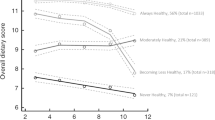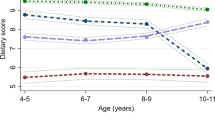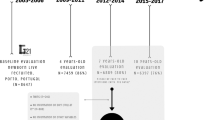Abstract
Objective:
High levels of insulin-like growth factor-I (IGF-I) are associated with an increased cancer risk and reduce risk of diabetes and coronary heart disease. We investigated associations of diet in childhood, in particular energy intake, with the IGF system in adulthood to determine if IGF-I – disease associations could be linked to early nutrition.
Design:
Retrospective cohort study.
Setting:
Sixteen survey centres in England and Scotland that originally participated in the Carnegie (Boyd Orr) Survey of Diet and Health in Pre-War Britain, 1937–1939.
Subjects:
Seven hundred and twenty-eight participants (679 with complete data) in the Boyd Orr cohort.
Methods:
Participants were originally surveyed between 1937 and 1939 (at median age 5.8 years; inter-quartile range: 2.9–9.6) and were followed up for 65 years. Dietary exposure in childhood was assessed from 7-day household food inventories. Outcomes are expressed as regression coefficients for the change in IGF per standard deviation increased childhood nutrient or food intake, as derived from levels of household consumption.
Results:
In fully-adjusted models, energy-rich family diets in childhood were not associated with IGF-I (regression coefficient: 0.9 ng/ml; 95% confidence interval (CI): −1.8, 3.7), IGF-II, IGF binding proteins (IGFBP)-2 or IGFBP-3 in adulthood. IGF-I was associated inversely with childhood family-diets high in milk (−2.5 ng/ml; −5.1, 0.1; P=0.05) and positively with vegetable-rich diets (3.5 ng/ml; 0.9, 6.1; P=0.009). IGF-I was not associated with family diets rich in protein, carbohydrates, fats, calcium, meat or fruit. IGF-II, IGFBP-2 and IGFBP-3 were not related to childhood family diet.
Conclusions:
This study suggests that energy-rich family diets in childhood do not program the IGF system in adulthood. As childhood diet was based on household consumption, however, measurement error may obscure individual-level diet-IGF associations. The associations of milk- and vegetable-rich family diets in childhood with IGF-I could be chance findings, but nevertheless are consistent with recent publications and warrant further investigation.
Sponsorship:
Funded by The World Cancer Research Fund (Grant No. 2001/31) with additional funds provided by UK Survivors. RMM was funded by a Wellcome Trust research training fellowship in clinical epidemiology (GR063779FR).
This is a preview of subscription content, access via your institution
Access options
Subscribe to this journal
Receive 12 print issues and online access
$259.00 per year
only $21.58 per issue
Buy this article
- Purchase on Springer Link
- Instant access to full article PDF
Prices may be subject to local taxes which are calculated during checkout
Similar content being viewed by others
References
Baker IA, Elwood PC, Hughes J, Jones M, Moore F, Sweetnam PM (1980). A randomised controlled trial of the effect of the provision of free school milk on the growth of children. J Epidemiol Community Health 34, 31–34.
Ben Shlomo Y, Holly J, McCarthy A, Savage P, Davies D, Gunnell D et al. (2003). An investigation of fetal, postnatal and childhood growth with insulin-like growth factor I and binding protein 3 in adulthood. Clin Endocrinol 59, 366–373.
Ben-Shlomo Y, Holly J, McCarthy A, Savage P, Davies D, Davey Smith G (2005). Pre and post natal milk supplementation and adult insulin-like growth factor I: Long term follow-up of a randomised controlled trial. Cancer Epidemiol, Biomarkers Prevent 14, 1336–1339.
Bingham SA, Gill C, Welch A, Cassidy A, Runswick SA, Oakes S et al. (1997). Validation of dietary assessment methods in the UK arm of EPIC using weighed records, and 24-h urinary nitrogen and potassium and serum vitamin C and carotenoids as biomarkers. Int J Epidemiol 26, S137–S151.
Bray I, Gunnell D, Holly JM, Middleton N, Davey Smith G, Martin RM (2006). Associations of childhood and adulthood height and the components of height with insulin-like growth factor (IGF) levels in adulthood: 65 year follow-up of the Boyd Orr cohort. J Clin Endocrinol Metab 91, 1382–1389.
Cadogan J, Eastell R, Jones N, Barker ME (1997). Milk intake and bone mineral acquisition in adolescent girls: randomised, controlled intervention trial. BMJ 315, 1255–1260.
Chan JM, Stampfer MJ, Giovannucci E, Gann PH, Ma J, Wilkinson P et al. (1998). Plasma insulin-like growth factor-I and prostate cancer risk: a prospective study. Science 279, 563–566.
Cheetham TD, Holly JM, Baxter RC, Meadows K, Jones J, Taylor AM et al. (1998). The effects of recombinant human IGF-I administration on concentrations of acid labile subunit, IGF binding protein-3, IGF-I, IGF-II and proteolysis of IGF binding protein-3 in adolescents with insulin-dependent diabetes mellitus. J Endocrinol 157, 81–87.
Davey Smith G, Greenwood R, Gunnell D, Sweetnam P, Yarnell J, Elwood P (2001). Leg length, insulin resistance, and coronary heart disease risk: The Caerphilly Study. J Epidemiol Community Health 55, 867–872.
Davey Smith G, Gunnell D, Holly J (2000). Cancer and insulin-like growth factor-I. BMJ 321, 847–848.
Elias SG, Keinan-Boker L, Peeters PH, Van Gils CH, Kaaks R, Grobbee DE et al. (2004a). Long term consequences of the 1944–1945 Dutch famine on the insulin-like growth factor axis. Int J Cancer 108, 628–630.
Elias SG, Peeters PH, Grobbee DE, van Noord PA (2004b). Breast cancer risk after caloric restriction during the 1944–1945 Dutch famine. J Natl Cancer Inst 96, 539–546.
Elwood PC, Haley TJL, Hughes SJ, Sweetnam PM, Gray OP, Davies DP (1981). Child growth (0–5 years), and the effect of entitlement to a milk supplement. Arch Dis Child 56, 831–835.
Fall CHD, Pandit AN, Law CM, Yajnik CS, Clark PM, Breier B et al. (1995). Size at birth and plasma insulin-like growth factor-1 concentrations. Arch Dis Child 73, 287–293.
Frankel S, Gunnell DJ, Peters TJ, Maynard M, Davey Smith G (1998). Childhood energy intake and adult mortality from cancer: the Boyd Orr cohort study. BMJ 316, 499–504.
Frobisher C, Tilling K, Emmett PM, Maynard M, Ness AR, Davey Smith G et al. (2007). Reproducibility measures and their effect on diet-cancer associations in the Boyd Orr Cohort. J Epidemiol Community Health (in Press).
Goodman-Gruen D, Barrett-Connor E (1997). Epidemiology of insulin-like growth factor-I in elderly men and women. The Rancho Bernardo Study. Am J Epidemiol 145, 970–976.
Gunnell D (2002). Can adult anthropometry be used as a biomarker for prenatal and childhood exposures? Int J Epidemiol 31, 390–394.
Gunnell D, Berney L, Holland P, Maynard M, Blane D, Frankel S et al. (2000). How accurately are height, weight and leg length reported by the elderly and how closely are they related to measurements recorded in childhood? Int J Epidemiol 29, 456–464.
Gunnell D, Okasha M, Davey Smith G, Oliver SE, Sandhu J, Holly JMP (2001). Height, leg length, and cancer risk: a systematic review. Epidemiol Rev 23, 313–341.
Gunnell D, Oliver SE, Donovan JL, Peters TJ, Gillatt D, Persad R et al. (2004). Do height-related variations in insulin-like growth factors underlie the associations of stature with adult chronic disease? J Clin Endocrinol Metab 89, 213–218.
Gunnell D, Oliver SE, Peters TJ, Donovan JL, Persad R, Maynard M et al. (2003). Are diet-prostate cancer associations mediated by the IGF axis? A cross-sectional analysis of diet, IGF-I and IGFBP-3 in healthy middle-aged men. Br J Cancer 88, 1682–1686.
Heaney RP, McCarron DA, Dawson-Hughes B, Oparil S, Berga SL, Stern JS et al. (1999). Dietary changes favorably affect bone remodeling in older adults. J Am Diet Assoc 99, 1228–1233.
Hjartaker A, Laake P, Lund E (2001). Childhood and adult milk consumption and risk of premenopausal breast cancer in a cohort of 48 844 women – the Norwegian women and cancer study. Int J Cancer 93, 888–893.
Holmes MD, Pollak MN, Hankinson SE (2002a). Lifestyle correlates of plasma insulin-like growth factor I and Insulin-like growth factor binding protein 3 concentrations. Cancer Epidemiol Biomarkers Prev 11, 862–867.
Holmes MD, Pollak MN, Willett WC, Hankinson SE (2002b). Dietary correlates of plasma insulin-like growth factor I and insulin-like growth factor binding protein 3 concentrations. Cancer Epidemiol Biomarkers Prev 11, 852–861.
Hoppe C, Molgaard C, Juul A, Michaelsen KF (2004a). High intakes of skimmed milk, but not meat, increase serum IGF-I and IGFBP-3 in eight-year-old boys. Eur J Clin Nutr 58, 1211–1216.
Hoppe C, Rovenna Udam T, Lauritzen L, Molgaard C, Juul A, Fleischer Michaelsen K (2004b). Animal protein intake, serum insulin-like growth factor I, and growth in healthy 2.5-y-old Danish children. Am J Clin Nutr 80, 447–452.
Isolauri E, Sutas Y, Salo MK, Isosomppi R, Kaila M (1998). Elimination diet in cow's milk allergy: risk for impaired growth in young children. J Pediatr 132, 1004–1009.
Juul A, Bang P, Hertel NT, Main K, Dalgaard P, Jorgensen K et al. (1994). Serum insulin-like growth factor-I in 1030 healthy children, adolescents, and adults: relation to age, sex, stage of puberty, testicular size, and body mass index. J Clin Endocrinol Metabol 78, 744–752.
Juul A, Scheike T, Davidsen M, Gyllenborg J, Jorgensen T (2002). Low serum insulin-like growth factor I is associated with increased risk of ischemic heart disease: a population-based case-control study. Circulation 106, 939–944.
Kaklamani VG, Linos A, Kaklamani E, Markaki I, Koumantaki Y, Mantzoros CS (1999). Dietary fat and carbohydrates are independently associated with circulating insulin-like growth factor 1 and insulin-like growth factor-binding protein 3 concentrations in healthy adults. J Clin Oncol 17, 3291–3298.
Langenberg C, Shipley MJ, Batty GD, Marmot MG (2005). Adult socioeconomic position and the association between height and coronary heart disease mortality: findings from 33 years of follow-up in the Whitehall study. Am J Public Health 95, 628–632.
Leighton G, Clark ML (1929). Milk consumption and the growth of school-children. Second preliminary report on tests to the Scottish board of health. Lancet i, 40–43.
Martin RM, Gunnell DJ, Pemberton J, Frankel S, Davey Smith G (2005a). The Boyd Orr cohort: an historical cohort study based on the 65 year follow-up of the Carnegie Survey of Diet and Health (1937–1939). Int J Epidemiol 34, 742–749.
Martin RM, Holly JMP, Davey Smith G, Ness AN, Emmett P, Rogers I et al. (2005b). Could associations between breastfeeding and insulin-like growth factors underlie associations of breastfeeding with adult chronic disease? The Avon Longitudinal Study of Parents and Children. Clin Endocrinol 62, 728–737.
Matthews DR, Hosker JP, Rudenski AS, Naylor BA, Treacher DF, Turner RC (1985). Homeostasis model assessment: insulin resistance and beta-cell function from fasting plasma glucose and insulin concentrations in man. Diabetologia 28, 412–419.
Maynard M, Gunnell D, Emmett P, Frankel S, Davey Smith G (2003). Fruit, vegetables, and antioxidants in childhood and risk of adult cancer: the Boyd Orr cohort. J Epidemiol Community Health 57, 218–225.
Maynard M, Gunnell D, Ness AR, Abraham L, Bates CJ, Blane D (2005). What influences diet in early old age? Prospective and cross-sectional analyses of the Boyd Orr Cohort. Eur J Public Health 16, 315–323.
Michels KB, Rosner BA, Chumlea W, Colditz GA, Willett WC (2006). Preschool diet and adult risk of breast cancer. Int J Cancer 118, 749–754.
Mucci LA, Tamimi R, Lagiou P, Trichopoulou A, Benetou V, Spanos E et al. (2001). Are dietary influences on the risk of prostate cancer mediated through the insulin-like growth factor system? BJU Int 87, 814–820.
Nelson M (1986). The distribution of nutrient intake within families. Br J Nutr 55, 267–277.
Ness AR, Maynard M, Frankel S, Smith GD, Frobisher C, Leary SD et al. (2005). Diet in childhood and adult cardiovascular and all cause mortality: the Boyd Orr cohort. Heart 91, 894–898.
Orr JB (1928). Milk consumption and the growth of school-children. Lancet i, 202–203.
Paganus A, Juntunen-Backman K, Savilahti E (1992). Follow-up of nutritional status and dietary survey in children with cow's milk allergy. Acta Paediatrica 81, 518–521.
Potischman N, Weiss HA, Swanson CA, Coates RJ, Gammon MD, Malone KE et al. (1998). Diet during adolescence and risk of breast cancer among young women. J Natl Cancer Inst 90, 226–233.
Price GM, Paul AA, Key FB, Harter AC, Cole TJ, Day KC et al. (1995). Measurement of diet in a large national survey: comparison of computerized and manual coding of records in household measures. J Human Nutr Diet 8, 417–428.
Pryor M, Slattery ML, Robison LM, Egger M (1989). Adolescent diet and breast cancer in Utah. Cancer Res 49, 2161–2167.
Renehan AG, Zwahlen M, Minder PC, O'Dwyer ST, Shalet PS, Egger PM (2004). Insulin-like growth factor (IGF)-I, IGF binding protein-3, and cancer risk: systematic review and meta-regression analysis. Lancet 363, 1346–1353.
Rogers I, Emmett P, Gunnell D, Dunger D, Holly J, the ALSPAC study team (2006). Milk as a food for growth? The IGF link. Public Health Nutr 9, 359–368.
Rogers IS, Gunnell D, Emmett PM, Glynn LR, Dunger DB, Holly JM et al. (2005). Cross-sectional associations of diet and insulin-like growth factor levels in 7- to 8-year-old children. Cancer Epidemiol Biomarkers Prev 14, 204–212.
Ross MH, Bras G (1971). Lasting influence of early caloric restriction on prevalence of neoplasms in the rat. J Nat Cancer Inst 47, 1095–1113.
Rowett Research Institute (1955). Family Diet And Health in Pre-War Britain. Carnegie United Kingdom Trust: Dunfermline.
Sandhu MS, Heald AH, Gibson JM, Cruickshank JK, Dunger DB, Wareham NJ (2002). Circulating concentrations of insulin-like growth factor-I and development of glucose intolerance: a prospective observational study. The Lancet 359, 1740–1745.
Stallings VA, Oddleifson NW, Negrini BY, Zemel BS, Wellens R (1994). Bone mineral content and dietary calcium intake in children prescribed a low-lactose diet. J Pediatr Gastroenterol Nutr 18, 440–445.
The Royal Society of Chemistry and MAFF (1991). McCance and Widdowson's the Composition of Foods, 5th edn. HMSO: London.
Thissen JP, Ketelslegers JM, Underwood LE (1994). Nutritional regulation of the insulin-like growth factors. Endocr Rev 15, 80–101.
van Noord PA (2004). Breast cancer and the brain: a neurodevelopmental hypothesis to explain the opposing effects of caloric deprivation during the Dutch famine of 1944–1945 on breast cancer and its risk factors. J Nutr 134, 3399S–3406S.
Wadsworth M, Hardy R (2003). Coronary heart disease morbidity by age 53 years in relation to childhood risk factors in the 1946 birth cohort. National Heart Forum. A Lifecourse Approach to Coronary Heart Disease Prevention. Scientific and Policy Review. Stationery Office: London.
Willett WC (1998). Nutritional Epidemiology. Oxford University Press: New York.
Willett WC (2000). Diet and cancer. Oncologist 5, 393–404.
Acknowledgements
We are very grateful to the cohort members who participated so willingly in the follow-up study. We also wish to acknowledge all the research workers in the original survey in 1937–1939. Claire Frobisher, Pauline Emmett and Maria Maynard undertook the re-analyses of the childhood household diet diaries and analyzed the food frequency questionnaire administered in adulthood. Jane Carter and Paul Savage performed the IGF analyses. Susie Potts is thanked for her secretarial and administrative support to the study. We thank all the GPs who participated in the study and the following for providing clinic space in 2002: Dr Nigel Williams (Clarkson Surgery, Wisbech); Professor Andrew Morris (Diabetes Centre, Ninewells Hospital, Dundee); Dr Ali Jawad (Royal London, Mile End); Sylvia Hey (Human Nutrition Unit, Rowett Research Institute); Professor Frank Sullivan (Mill Practice, Dundee); Professor Philip Hannaford (Aberdeen University).
Author information
Authors and Affiliations
Corresponding author
Additional information
Contributors: The hypothesis was developed by DG, GDS, RMM, JMPH. The fieldwork was conducted by RMM and Simone Watson under the direction of a steering group (Shah Ebrahim, GDS, Stephen Frankel, DG, JMPH). NM did the statistical analysis. RMM wrote the first draft and co-ordinated completion of the paper. RMM had full access to all the data in the study and takes responsibility for the integrity of the data and the accuracy of the data analysis. All authors critically commented on and edited earlier drafts and approved the final version of the paper.
Rights and permissions
About this article
Cite this article
Martin, R., Holly, J., Middleton, N. et al. Childhood diet and insulin-like growth factors in adulthood: 65-year follow-up of the Boyd Orr Cohort. Eur J Clin Nutr 61, 1281–1292 (2007). https://doi.org/10.1038/sj.ejcn.1602616
Received:
Revised:
Accepted:
Published:
Issue Date:
DOI: https://doi.org/10.1038/sj.ejcn.1602616
Keywords
This article is cited by
-
Effect of a pediatric fruit and vegetable prescription program on child dietary patterns, food security, and weight status: a study protocol
BMC Public Health (2022)
-
Does milk intake promote prostate cancer initiation or progression via effects on insulin-like growth factors (IGFs)? A systematic review and meta-analysis
Cancer Causes & Control (2017)
-
Maternal milk consumption, birth size and adult height of offspring: a prospective cohort study with 20 years of follow-up
European Journal of Clinical Nutrition (2013)
-
Epithelial cancers in the post-genomic era: should we reconsider our lifestyle?
Cancer and Metastasis Reviews (2013)
-
The effects of whole milk and infant formula on growth and IGF-I in late infancy
European Journal of Clinical Nutrition (2009)



